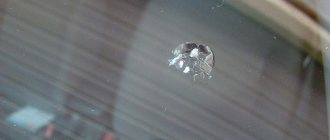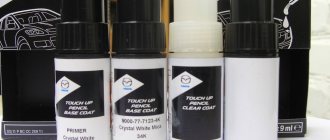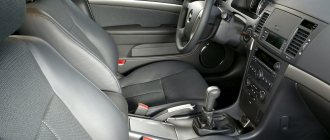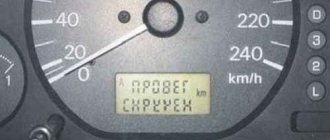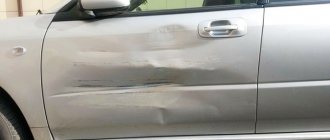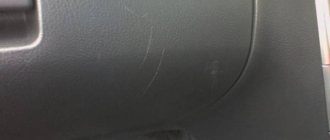Plastic is a sensitive surface. Therefore, it must be handled carefully. Excessive heating should be avoided, otherwise the surface will begin to melt. At the same time, however, to achieve the desired result on the surface, a car interior plastic polish is needed. A thicker polish has a cooling effect.
When using polishing pastes, there is always a risk that excessive residue will be left on the surface when polishing the plastic. To avoid this, a precise pre-grinding process and short polishing times are especially important. In this article we will talk about how to do this correctly and make a rating of polishes for car plastics
Types of polishes
Polishes come in four main types:
- Silicone polishes
They contain silicone, wax and other cleaning agents. When polished, they remove water-soluble contaminants from the surface of the plastic and form a hard, smooth film. Their smoothness makes them dust-repellent and easy to wipe off dirt.
- Emulsion polishes , sometimes referred to as cream polishes, are composed of water, oil, and cleaning agents that allow them to remove water-soluble and oily deposits from the surface of plastics while polishing. However, they create a matte or satin finish that is more prone to dust and will be more difficult to clean.
- Oil-based auto polishes typically contain a mineral oil base and may also contain solvents such as petroleum distillate. The thin oil film they leave gives a rich, shiny result, but just like emulsion ones, they attract dust.
- Waxes
These products range in consistency from creamy wax, which provides a more matte or satin finish, to paste, which provides a dust-resistant, high-gloss finish. The thin, hard layer they provide protects against stains and scratches.
Polishes also differ in the method of application.
- Aerosol
They come in a tin and make up the bulk of car dashboard polishes for obvious reasons. They require the least amount of work to get started, simply press the button on the can to spray the product under pressure directly onto the plastic to polish it, no need to use a cloth or rub it into the material.
- Liquid polishes include emulsions and oil-based products; they come in bottles that allow you to squirt polish onto a damp cloth and then rub it into the plastic. The work does not take much time, however, oil bases require more work time than emulsion ones. You can also find disposable wipes that are pre-soaked in liquid polish, all you have to do is take the wipe and wipe the plastic parts of your car with it.
- Semi-solid polishes are wax-based products that are usually sold in a small jar. They require more work by applying the product to the fabric and then thoroughly rubbing it into the plastic, but there are cream waxes that require less work than their paste counterparts.
Plastic restorer
This tool is universal. With its help, you can update and restore not only platinum, but also vinyl decorative elements with your own hands.
In such a situation, you cannot do without abrasives and sanding the surface.
The finished composition must be applied to the damaged areas so that it penetrates deeply into the structure and fills the entire volume. After the product has hardened, it is enough to polish the surface with special wipes.
The cost of plastic restorers starts from 200 rubles.
TOP polishes for car interior plastic
On the Russian market we have a huge selection of polishes for car plastic to prevent scratches. Additionally, manufacturers are constantly trying to outdo each other by introducing new products. We've created our ranking of the best car plastic polishes to help you choose the perfect product. We evaluated pastes from leading manufacturers.
When conducting the evaluation, we were guided by such criteria as aggressiveness, effectiveness of the paste, and, finally, value for money. Let's find out which car plastic polish to choose?
Menzerna FG 400
The size of the Menzerna FG 400 abrasive becomes smaller and smaller during the polishing process, thanks to which a good result can be achieved.
The car polish is available in small bottles of 250 ml as well as 1000 ml. We can recommend Menzerna FG 400 car polish without any doubt. We think this is the best car plastic polish.
Meguiars Ultimate Compound
First of all, the price of the product is very low, but the polishing performance was very good and the product was not bad when Meguiars tested it. This product is suitable for hand polishing. But you can also get good results with a polishing machine.
Meguiar's Anti-Gloss Car Plastic Scratch Polish is actually an all-purpose car polish. Whether swirl marks, deep scratches, machine polishing or hand polishing, we were able to remove every possible type of scratch in our test with Meguiars Ultimate Compound.
This product is easy to work with and has not caused any problems.
The polish has a smell similar to marzipan. It smells a little chemical, but it doesn't seem unpleasant even after long periods of use. Meguiars car polish is highly visible throughout the polishing process, so you'll always know where you polished and where you didn't. The downside of this product is that it takes a long time to dry.
The kit also includes a microfiber cloth.
Mothers
This is a polish for plastic car headlights, however, it is perfect as a means for polishing plastic elements in the car interior.
Mothers combines the best characteristics we expect from highly abrasive pastes. Great for removing scratches, the paste is highly aggressive and also very effective. Mothers Heavy Duty has the best value for money.
Menzerna PF 2200
This car polish has all the characteristics typical of Menzerna. With this product you can very easily get rid of swirls and small scratches. After polishing with Menzerna PF 2200, we recommend another pass with Menzerna SF3800 to get the best result.
This is a good polish for car exterior plastics and is ideal as an interior dashboard polish. Menzerna is more common among professional equipment, but we've tested many products like PF2200 simply because the company's car polishes are cheap and work very well on all surfaces of the car.
CLEANEXTREME
This product is a water-based polishing paste, no silicone oil, no wax, suitable for hand polishing and for use with a polishing machine.
Suitable for all glossy plastic surfaces, including acrylic, plexiglass, macrolon, polyester, polycarbonate and fiberglass. Designed to remove minor scratches, signs of wear, stains and dirt (lime and heavy deposits).
Polishing car plastic from scratches
The car interior is heavily exposed to mechanical stress. Therefore, scratches and defects in the plastic often appear. Like body repairs, such repairs also cost a pretty penny. Is it possible to polish the plastic of a car on your own at home? The most commonly used methods for restoring plastic are restorers and gel plasticizers with further polishing. Whether the procedure will be effective largely depends on the depth of the defects and damage. Let's take a closer look at how to perform this procedure yourself.
Polishing plastic parts of a car is one of the most effective methods of combating surface damage. With it you can easily get rid of small scratches, make large ones almost invisible, restore the material and make the car more attractive.
To remove scratches from plastic, car body polishing is used. Do not forget that plastic itself is a rather fragile material, so not all abrasive materials are suitable for it. It is strictly forbidden to use those materials that are needed when polishing metal parts of a car. Such products can destroy plastic. In this case, milder drugs are used.
How much abrasive should I apply? To do this, the depth of the damage is measured. At the initial stages of processing, abrasives are used with large grain sizes. In the following stages, the grains are gradually reduced. The final processing is done with felt. A polishing material without abrasives is taken. This restores the surface and gives it a glossy shine.
At what level should this or that grain level be:
- for deep defects: from four hundred to six hundred;
- to add gloss: from a thousand to one and a half thousand;
- for final polishing - from two thousand or using a paste without abrasives.
Specialists in competent companies first assess the size of the defects and then decide on the use of one or another polish. Before contacting a particular service, read carefully the information about the company.
How to properly polish the plastic of a car interior with your own hands.
When a product for polishing the car’s plastic has been selected, you can proceed with the repair work itself with peace of mind. Polishing parts is divided into several stages; let’s look at them in more detail:
- Initially prepare the work surface from any remaining dirt and wash it thoroughly with cleaning agents;
- wipe the surface dry with a clean napkin or rag;
- degreasing the surface. This is a rather controversial procedure; some experts recommend it, and some do not. It’s better to do degreasing, it definitely won’t do any harm;
- If you find deep defects on the plastic surface, take sandpaper. Use it to remove the layer that has scratches;
- then treat the area with abrasives. Their grain size should be coarse;
- During the working process, periodically apply water. All this is done to ensure that the surface does not heat up during the procedure. This is very important when carrying out all work manually;
- The final stage will be treating the damaged surface with polishes with a restorative effect. The main thing is that there are no abrasive substances there. It is better to choose car wax. This product will ideally make all unevenness invisible, and add external gloss and shine. In addition, wax has excellent protective properties. If the exterior of your vehicle does not need shine, then use matte products. Do not use polishes that are intended for bodywork. Read the instructions carefully and don't waste your money.
There is a group of experts who advise doing polishing exclusively by hand.
Indeed, plastic is very soft and therefore requires careful handling. A sander can greatly damage the appearance of the surface. There are other experts who claim the benefits of grinding machines. The main thing is to carry out all work extremely carefully and carefully. Sometimes you can use a hairdryer while working. It serves to heat the surface and tighten damaged areas. At the first signs of heating of the surface, you should stop working with the electrical appliance. Then work with polishes with a restoring effect.
Polishing the plastic of the car interior conclusion.
Plastic machine parts require more careful restoration compared to metal parts.
The defects are more noticeable on them. You can only get rid of them with abrasive polishes. Choose a polishing agent depending on the size of surface defects.
Correctly selected polishes will give a beautiful appearance and shine to your “iron horse”. come back
Conclusion
What is the best polish for car plastic? Menzerna makes very good polishing products for polishing machines. You can't go wrong with the FG 400 from Menzerna. It is suitable for rougher scratches. After polishing, a shine appears that usually surpasses the shine of a new car.
We also really liked the Meguiars polishes and can therefore recommend them. Most Meguiars products, such as Ultimate Compound, can be used by hand.
Meguiars Ultimate Compound is available directly with an applicator and microfiber cloth. For beginners, we recommend the Meguiars Starter Kit. It includes a variety of car polishes and everything you need to remove scratches and dirt from plastics and other car surfaces.
All car polishes presented in the list have been tested and evaluated by us to the best of our knowledge and maximum neutrality. We are not responsible for misuse or damage to vehicle surfaces.
Let's sum it up
You can tell a lot about a person by the appearance of a car. And in order for only positive things to be said about the driver, the car needs to be monitored and taken care of on time. Most often, drivers try to make their car better by polishing the body and plastic.
Plastic includes various plastic parts, such as bumpers, moldings and other various elements that complement the appearance of the car. Before starting work, you need to select the necessary polishing agent for metal and plastic parts. Upon completion of the work, you should cover the parts with a protective layer; this is necessary to preserve the shine that the body and plastic parts acquired after the polishing process.
How to apply and polish
Scratches on plastic, unfortunately, are not as easy to remove as, for example, unsightly stains on wood. Unless the scratch is very deep, you don't have to put up with it. It is repairable.
- Before treating scratches on plastic, first thoroughly clean the surface.
- First, clean the area around the scratch with warm, soapy water.
- Then wipe the surface thoroughly with a soft cloth.
- Then dry the area thoroughly with a soft cloth.
- Treat surface scratches with a polishing paste suitable for plastic.
- The procedure is similar to polishing plexiglass. Apply a suitable solution to a clean cloth and wipe the scratch with it.
- Then buff the surface with a clean, soft, preferably lint-free cloth.
- If there are deep scratches, you should sand the surface with fine-grit sandpaper. Use 800 grit sandpaper. Important! moisten the paper before use.
- Then thoroughly clean the area again and sand again with 1500 grit sandpaper. Finally, sand the area as described above.
To avoid damaging the plastic, never polish in one place for too long, as the plastic may melt (this rule only applies to polishing with a machine or other special tool), never use car plastic polish from an unknown manufacturer. Before polishing, make sure that the rag or felt pads you want to work with are absolutely clean and that there are no grains of sand or other dirt on them.
Using polishes and gels
If using microfiber does not remove the scratch from the plastic of the car, you can try special gels and polishes. Well-proven products for eliminating plastic defects include Displex and Disc Repair. They can be bought in both hardware stores and automotive stores. It is worth noting that specialized automotive stores sell products with similar compositions, designed specifically for removing scratches from plastic in the car interior.
Article on the topic: The starter turns for a long time when starting the engine
Removing scratches from a car interior using polish is a very simple process. You will need to apply a little product to a cotton swab and rub it over the scratched surface. When rubbed, the gel particles penetrate into the grooves of the scratches, completely covering them. When the defect in the plastic becomes almost invisible, you must wait 30-50 minutes until the product has completely hardened before touching the surface.
